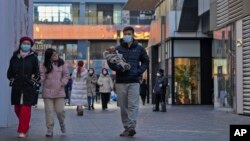With a major shift in China's COVID-19 policy, Beijing is putting the focus back on economic growth. To lessen the blow to the domestic economy from the surge of infected people, Chinese officials and companies are letting people who test positive for COVID-19 return to work, even though that could accelerate the spread of the virus.
Industrial production in China is continuing to contract in the aftermath of strict coronavirus-related restrictions that disrupted factory activity and supply chains. According to data released by China's National Bureau of Statistics on Tuesday, the profits of domestic industrial enterprises above a designated size fell by 3.6% year-on-year from January to November to 7.7 trillion yuan (about $1.11 trillion U.S. dollars).
Although China abandoned some strict epidemic safeguards in early December and announced this week that it would resume outbound tourism as well as scrap tests and quarantine for arrivals in January, the recovery of domestic productivity is under pressure.
Most of China's population is infected, or is at risk of contracting the coronavirus, making work difficult for those recovering, or at risk of contracting the coronavirus. According to Reuters, business confidence in China has fallen to its lowest level since January 2013.
Officials prioritize economy
At an annual closed-door economic conference in mid-December, Chinese leaders issued a statement pledging to step up policy adjustments to support the slowing economy, calling stabilization of economic growth a top priority for 2023. With the big shift in central policy, the focus of local governments is shifting from virus containment to economic growth.
To maximize the resumption of work and production and keep the economy running, Beijing, Zhejiang, Chongqing, Anhui and Guiyang have recently allowed patients with asymptomatic or mild COVID-19 symptoms to return to work.
The outbreak has already created a shortage of workers in health care, logistics and supermarkets. The city of Hangzhou, China's tech hub, issued a notice last week urging citizens who have spare time to participate in food delivery. Such moves reflect the difficulties officials face as they try to revive the economy.
Signs of growth
Louise Loo, a China economist at Oxford Economics, told VOA Mandarin that analysts are already forecasting a minor economic boost in response to the new measures.
“We see a 0.8% boost to GDP [gross domestic product] just from an orderly reopening alone,” said Loo. “This is smaller than the boost we see in other East Asian economies’ reopening experiences, given our expectations of the relative lack of pent-up demand among Chinese consumers.
“A disorderly reopening, i.e., easing too fast, too soon, would pose downside risk to this outlook,” Loo added.
China’s official shift from zero-COVID to co-existing with the virus has posed serious challenges to manufacturing. Compared with most white-collar jobs that can be done from home, workers must go to factories to complete manufacturing and assembly.
According to the Caixin China Manufacturing PMI, China's manufacturing industry continued contracting through November as a result of COVID control measures that prevented factories from operating at full capacity.
Some factories, however, have continued or adopted a "closed-loop" production system with workers eating and living in the factory to minimize external COVID exposure, an approach some factories took during major outbreaks and lockdowns.
Other factories are trying to extend shifts to make up for lost production as workers take time off work, while yet others have loosened controls entirely, allowing workers infected with COVID to continue to work.
China’s Sina outlet reported Wednesday that some assembly line workers at Foxconn's Zhengzhou factory continued to work after being infected with COVID. In order to keep more employees at work, Foxconn has issued attendance awards and retention bonuses, and has prepared isolation dormitories for infected people.
Foxconn, along with a handful of other global manufacturers, is also shifting some production to India and Vietnam.
Chinese state-owned enterprises are also returning to full production.
Inherent risks
Efforts to boost economic growth, however, come at a cost, as keeping COVID-positive personnel on site risks spreading the virus.
According to data from analytics firm Airfinity, China may now be seeing as many as 1 million COVID-19 infections and 5,000 COVID-19 deaths per day.
Another study by the University of Macau and Harvard Medical School shows that as many as 1.5 million people could die in the next six months as China’s comparatively late initiative to co-exist with COVID takes shape.
Although some foreign companies in China agree with the direction of China's reopening, they are worried about the current chaos and the uncertainty of their business prospects.
“Our members’ first priority is the health and wellbeing of their employees and their families,” the U.S.-China Business Council told VOA Mandarin.
“Given the pace at which China’s COVID-19 policies are changing ... members have had little time to react,” the EU Chamber of Commerce in China told VOA Mandarin in a statement. “Members are now planning for scenarios where they may be able to continue their general operations in spite of a rise in cases. This is not an easy task at the moment.”
Many in China are also dissatisfied with the government's shift in its COVID policy, believing stimulation of economic growth is coming at the expense of public health.
“As long as no one dies, the company doesn’t care whether we tested positive or not. Everyone has to go to work,” wrote a user on Weibo, the Chinese equivalent of Twitter.
Others worry about losing their jobs altogether, especially as China's economic weakness over the past few years has caused a reduction in household incomes.
“Complaint sounds like a good idea [if] you don’t want your job anymore,” wrote one Weibo user. “Otherwise, who dares to complain?”
Adrianna Zhang contributed to this report. This story originated in VOA's Mandarin Service.








